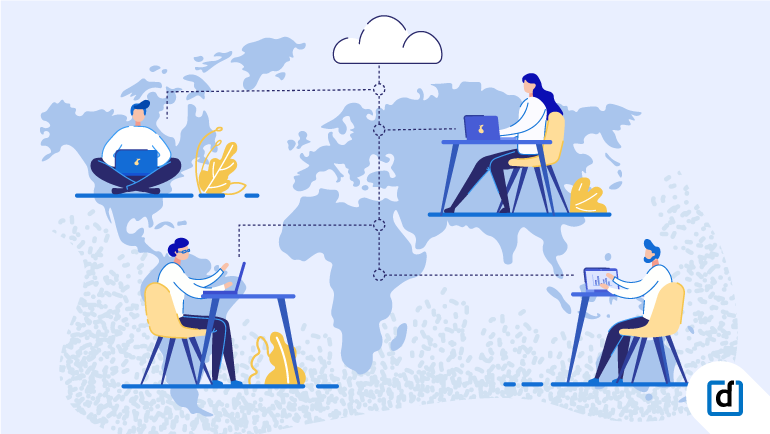
The pandemic has been unprecedented on several counts, not just in terms of its magnitude but also in how it has changed the way we work. Early digital adopters found their foresight rewarded as they could transition to remote working seamlessly while digital laggards struggled to make the transition. Regardless, the company’s existing HR tech infrastructure has had to adapt promptly to the rapidly evolving business scenario.
“Remote working is no longer a nice-to-have perk offered to employees rather a core foundation on which the success of any future business stands.”
Here are some other vital aspects that you need to consider when you adapt your HR Tech infrastructure to today’s world of remote work.
-
Supporting human interaction
The absence of face to face interaction can indeed be demoralizing for the workforce. Tasks that require group collaboration and feedback are the hardest hit with the current remote working set-up. At such times the role of the HR department becomes all the more poignant. You could consider using technology to facilitate engagement and find ways to remain connected virtually for informal interactions. Keeping in mind the current times, the HR teams would need to communicate and extend logistical support and psychological support. And, tech applications can create avenues to maintain a seamless and direct line of communication continuously.
-
Facilitating Collaboration
Collaboration tools are the mainstay of any remote working situation. These applications should facilitate conferencing over the video, holding chats, jointly working on documents, and more. While specific requirements would vary across industries, a video conferencing application, a messaging app, and a collaboration platform form the crux of the remote requirements. Pulse surveys to check-in on employees’ morale frequently could also help highlight the need for timely HR interventions to keep employees motivated while working remotely.
-
Business Continuity
After the unprecedented chaos that was ensured in the post-pandemic world, ensuring business continuity must be a top priority for a tech infrastructure to support the future of remote working. Vulnerability analytics to track high-risk employees and ensure they are not called to the office and reduce the risk of more employees becoming susceptible to the virus is number one. Health surveys to continuously monitor symptoms and calculate risk scores. It is also essential to make sure work can go on in the case of unexpected illness or unavailability of individual employees.
“Tech infrastructure that supports the future of work must ensure agility and flexibility to adapt to changing circumstances.”
-
HR operations
HR strategies and software need to be optimized for remote working. For example, which positions are eligible to work from home? What are the timings that the workforce would adhere to? How will productivity and accountability be maintained in remote working?
Several HR processes can be streamlined and shifted to the cloud. Payroll management, analytics, the gamut of recruitment processes, onboarding processes, and so on, can all be effectively integrated on the cloud. An online training repository could also be created to upskill the workforce to keep up with the times. Tracking in terms of hours on the job and monitoring performance against goals set becomes crucial.
More sophisticated time tracking software to ensure monitoring of tasks assigned and completed might be necessary. We launched Darwinbox Evolve with features like geotagging, facial recognition, task completion, and more to ensure productivity does not hit the mandatory remote working. Deep-tech solutions like geotagging and facial recognition to manage attendance, help ensure productivity while working from home.
-
Cybersecurityand Compliance
Cybersecurity is indeed one of the most pressing issues for today’s times. The intensity and frequency of cyber-attacks have increased in the recent past. Safeguarding and ensuring data security is of primary importance as employees working remotely are offered access to business sensitive information.
The CIO’s concerns for cybersecurity while adapting to enable remote work spans the beyond HR tech to the entire tech infrastructure. Some of these concerns include updated data privacy and protection rules, the legal implications thereof, malleability of the infrastructure to accommodate concerns, investments required for increased security, assessment of security risks that are physical when data is accessed off-site, and most importantly, training all employees to be vigilant and aware of the issue of cybersecurity.
Government rules regarding optimal on-site workers and constantly changing attendance policies and guidelines in the wake of the evolving situation with the pandemic is a valid concern. Beyond the pandemic-imposed guidelines, several other compliances like the General Data Protection Regulation or the GDPR concerns companies dealing with European nations, or ISO compliance, SOC Type 1 and Type 2 reporting, and more. The company needs to automate and maintain proofs for compliance, and technology can help with that. The future tech infrastructure needs to meet these predefined criteria to avoid wasting hours dealing with compliance manually.
Flexible working policies have already started making inroads into the world of work. The pandemic may have opened up a whole new possibility of tech-empowered remote work. With time as we move towards a new normal many of these practices and HR Tech infrastructure will act as the base on which the future of work and the organisation’s success stand. At Darwinbox, we pride ourselves on supporting enterprises to be future-ready with our agile end-to-end HRMS suite. With a single interface for talent acquisition, workforce management, payroll and expense management, and deeper people analytics, our solutions are the preferred choice for HR Tech across industries.



Speak Your Mind